
The former Royal Burgh of Lauder is a town in the Scottish Borders in the historic county of Berwickshire. On the Southern Upland Way, the burgh lies 27 miles (43 km) southeast of Edinburgh, on the western edge of the Lammermuir Hills.
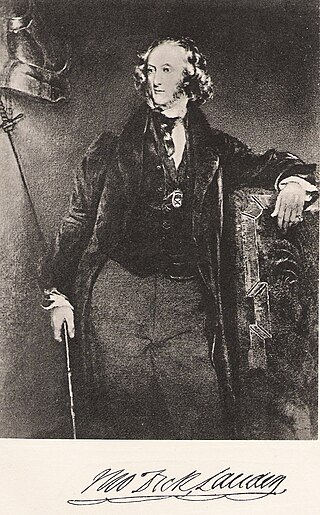
Sir Thomas Dick Lauder of Fountainhall, 7th Baronet, FRSE FSA (Scot) LLD was a Scottish author. He served as Secretary to the Board of Manufactures (1839–), on the Herring Fisheries Board, at the Royal Institution for the Encouragement of the Fine Arts, and as Deputy Lieutenant of both counties of Moray and Haddington.
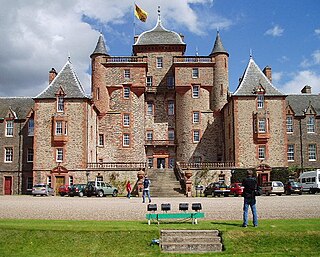
Thirlestane Castle is a castle set in extensive parklands near Lauder in the Borders of Scotland. The site is aptly named Castle Hill, as it stands upon raised ground. However, the raised land is within Lauderdale, the valley of the Leader Water. The land has been in the ownership of the Maitland family since 1587, and Thirlestane served as the seat of the Earls of Lauderdale. The castle was substantially extended in the 1670s by the first and only Duke of Lauderdale. Further additions were made in the 19th century. The castle is now cared for by a charitable trust, and is open to the public.

The Grange is an affluent suburb of Edinburgh, just south of the city centre, with Morningside and Greenhill to the west, Newington to the east, The Meadows park and Marchmont to the north, and Blackford Hill to the south. It is a conservation area characterised by large early Victorian stone-built villas and mansions, often with very large gardens. The Grange was built mainly between 1830 and 1890, and the area represented the idealisation of country living within an urban setting.
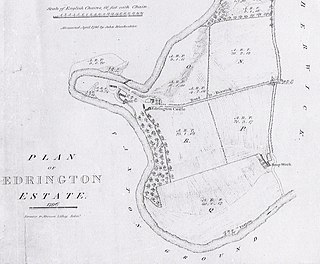
Edrington is a medieval estate occupying the lower part of Mordington parish in Berwickshire, Scotland, five miles (8.0 km) west of Berwick-upon-Tweed. From probably the 14th century, if not earlier, a castle occupied the steep hill above the mill of the same name on the Whiteadder Water. The castle ruin is still marked on today's Ordnance Survey maps, and still appears in locality references in The Berwickshire News. The principal farm of the estate is Edrington Mains.
There has been one baronetcy granted to the Lauder family. The baronetcy of Lauder of Fountainhall, Haddingtonshire, was created for John Lauder, last surviving male representative of the Lauders of that Ilk, a rich merchant-burgess and sometime Treasurer and baillie of the City of Edinburgh Council, and an armiger. He purchased the estate of Newington, Edinburgh, and subsequently the lands of Woodhead and Templehall near Pencaitland, which along with others in Edinburghshire and Haddingtonshire, were erected by Crown charter into the feudal barony of Fountainhall on 13 August 1681.
Sir Andrew Lauder of Fountainhall, 5th Baronet was a Burgess of the Royal Burgh of Lauder, and also of Musselburgh.
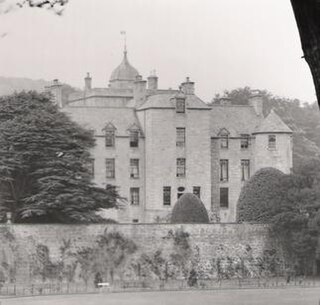
Haltoun House, usually known as Hatton House,, was a Scottish baronial mansion set in a park, with extensive estates in the vicinity of Ratho, in the west of Edinburgh City Council area, Scotland. It was formerly in Midlothian, and it was extensively photographed by Country Life in September 1911.
George de Lawedreof Haltoun was a Burgess and Provost of Edinburgh in the early 15th century.
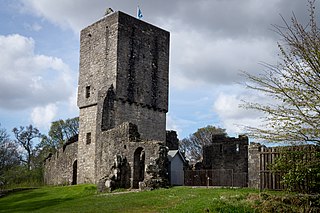
Mugdock Castle was the stronghold of the Clan Graham from the middle of the 13th century. Its ruins are located in Mugdock Country Park, just west of the village of Mugdock in the parish of Strathblane. The castle is within the registration county of Stirlingshire, although it is only 2 kilometres (1.2 mi) north of Milngavie, East Dunbartonshire, on the northern outskirts of Greater Glasgow.
Robert Lauder of The Bass was an important noble in Haddingtonshire, the Merse, and Fife. Stodart remarks that "to 1600 the barons of the Bass sat in almost every parliament". He was a firm supporter of Mary, Queen of Scots whom he accompanied to Carberry Hill on 14 June 1567, and fought for at the battle of Langside.
Tyninghame is a small settlement in East Lothian, Scotland, about two miles north-east of East Linton. Together with the nearby settlement of Whitekirk, it gives its name to the parish of Whitekirk and Tyninghame.

Tyninghame House is a mansion in East Lothian, Scotland. It is located by the mouth of the River Tyne, 2⁄3-mile (1.1 km) east of Tyninghame, and 3+3⁄4 miles (6.0 km) west of Dunbar. There was a manor at Tyninghame in 1094, and it was later a property of the Lauder of The Bass family. In the 17th century, it was sold to the Earl of Haddington. The present building dates from 1829 when the 9th Earl of Haddington employed William Burn to greatly enlarge the house in the Baronial style. In 1987 the contents of the house were sold, and the house was divided into flats.
Marie Maitland was a Scottish writer and poet, a member of the Maitland family of Lethington and Thirlestane Castle, and later Lady Haltoun. Her first name is sometimes written as "Mary".
Sir James Dick of Prestonfield was a 17th and 18th century Scottish merchant who served as Lord Provost of Edinburgh from 1679 to 1681. He was the first Baronet of Prestonfield and was progenitor to the Dick baronets.

Sir William Dick of Braid (1580–1655) was a 17th-century Scottish landowner, banker and merchant who served as Lord Provost of Edinburgh from 1638 to 1640. His fortunes took him from being "the richest man in Scotland" in 1650 to his death as a pauper a few years later.

Lawthorn is a hamlet near Perceton in Strathannick, Irvine, North Ayrshire, Scotland. The settlement lies on the old Irvine to Stewarton toll road.
Patrick Cumin or Cuming (1695–1776) was a senior clergyman in the Church of Scotland. He was three times Moderator of the General Assembly.

Bass Castle is a castle on Bass Rock located off the coast of North Berwick, Scotland.
Muircleuch Tower was a peel tower house located near Muircleuch, Scottish Borders, Scotland.











